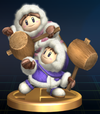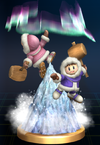Ice Climbers (SSBB)
| Ice Climbers in Super Smash Bros. Brawl | |
|---|---|
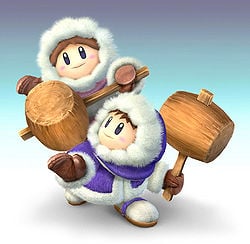 
| |
| Universe | Ice Climber |
| Other playable appearances | in Melee in Ultimate |
| Availability | Starter |
| Final Smash | Iceberg |
| Tier | S (2) |
The Ice Climbers (アイス クライマー, Ice Climber) are veteran playable characters in Super Smash Bros. Brawl. The duo were officially confirmed on the Smash Bros. DOJO!! website on September 14, 2007, alongside the rest of the returning veterans. As in Super Smash Bros. Melee, the Ice Climbers are the archetypical tag-team fighters in Brawl, although the leading climber is fundamentally controllable by the player, the following climber is controlled by a CPU, in a manner mimicking the player.
The Ice Climbers are once again voiced by Sanae Kobayashi, with a combination of recycled voice-clips from Super Smash Bros. Melee and new ones for Brawl.
The Ice Climbers rank 2nd on the current tier list, ranking them in the S tier, a slight improvement over their ranking in Melee, where the duo were 8th out of 26. In addition to being the game's highest-ranking veteran, this is rendered their best placement in the series to date. This is primarily due to their extensive and intricate grab game that can potentially lead to an inescapable zero-to-death combo on the entire cast regardless of the stage. The unique two-in-one mechanism of the character also forces opponents to rethink their approach, as a single climber can easily disrupt combos and chain grabs. The duo also have a pair of decent and flexible projectiles, Ice Shot and Blizzard, allowing them to outcamp their opponents, and the Ice Climbers benefit from a solid grounded and aerial game, courtesy of their effective tilts, powerful smash attacks and aerial attacks (with forward aerial being a relatively powerful meteor smash, and up aerial being large and disjointed). In addition, the Ice Climbers have some of the greatest damage output across the entire cast in Brawl, which is supplemented by their high KO potential, quick frame-data and chain grabbing. If the following climber is KO'd during the stock, however, the remaining climber has drastically nerfed recovery, effectiveness on their special moveset, damage output and KO potential, especially due to their inability to perform a meteor smash, and is considerably more vulnerable to chain grabs and combos. The Ice Climbers also have poor momentum canceling abilities, which when combined with their light weight, makes the Ice Climbers vulnerable to early KOs. The duo's poor mobility also hinders their ability to approach and allows speed demons (like Sonic and Captain Falcon) to outmanuever them easily. Despite a long-ranged tether recovery, their recovery often costs the partner if not tethered. Regardless, the Ice Climbers have dominating matchups (losing to only four characters, with Meta Knight being the only top-tier the duo lose to), and excellent tournament results.
Attributes
The Ice Climbers are a pair of lightweights (tied with Toon Link for the 10th-lightest) with attributes that drastically deviate themselves from other characters of their weight class. The duo are characterized with high KO potential, outstanding damage output, good range, and quick frame-data, yet are burdened with relatively slow mobility; together, the duo have below-average dashing speeds, the 4th slowest air speeds, and are tied for the 5th slowest falling speeds. However, their walking speeds are average, their jumping height and air acceleration are both above-average. These stats hinder their ability to approach, especially in the air. However, with their devastating grab game, the Ice Climbers themselves are formidable to approach.
Unique to a majority of the roster, the Ice Climbers are the archetypical tag-team fighters in Brawl. Together, however, each Ice Climber is a unique character in their own right. The partner (Nana, by default) is controlled by a CPU and mimics what the leader (Popo, by default) performs with a seven-frame delay. As such, the player is essentially controlling a pair of characters at the same time with slight tweaks; the follower inflicts less damage and/or knockback and has less KO potential, but only the follower can meteor smash with their forward aerial. The Ice Climbers are able to grab a pair of different items and are even able to grab a pair of separate opponents. In addition, their unique property also makes them much harder to grab and throw effectively (when a single Ice Climber gets grabbed, the other climber can simply counterattack, making them immune to chain grabs and, to a lesser extent, combos). Conversely, this allows them to have a superior grab game fudamentally unique to them. However, they can easily be separated by powerful attacks. In this scenario, it is advisable to stick to and protect the partner, even if it lures the leader in additional danger. Should the CPU-controlled Ice Climber get KO'd during the stock, the remaining Ice Climber will have drastically reduced damage output, KO ability, and recovery, with Belay becoming practically useless and Squall Hammer losing a good deal of distance (whereas with both Climbers, both are excellent recovering moves). While Belay is a safe and long-ranged tether recovery, it often costs the partner if Belay is non-tethered.
As a dymanic duo, the Ice Climbers are capable of inflicting exceptional damage output on their opponents in seconds. In addition, the duo boast excellent KO ability, although their smash attacks are more suitable for racking up damage than KOing, and most of their moveset are burdened with low base knockback. The duo are also gifted with a flexible special moveset. The duo's neutral special move, Ice Shot, is an icy projectile fired by each Ice Climber which slides along the ground, making it impossible to avoid by crouching/crawling. Unlike most projectiles, the ice acts more like a container or soccer ball in that the incoming projectile is completely stop, allowing the Ice Climbers to counter most projectile-spam playstyles more easily. At extremely high percents, it can also freeze opponents, allowing use of setups or reads. The ice's decent amount of hitstun also make it useful for edgeguarding. Blizzard, their down special, can freeze opponents and even cover both sides if the partner is present, or alternatively can be made to cover a single side if performed while jumping with the partner, giving the attack more power. Squall Hammer is a decent approaching tool with good damage and mobility, spinning the Ice Climbers around each other with their hammers outstretched, allowing them to easily circumvent their poor mobility. The final hit deals moderate knockback, allowing it to KO at high precents. Belay, their up special, is a powerful KO move should the following climber connect with the opponent, but it is overall risky for usage because it separates the Ice Climbers and sends them into helplessness.
A unique fighter ability to the Ice Climbers is that the duo's traction is completely unaffected by the conditions of slippery surfaces and terrain, such as ice, meaning that the Ice Climbers will not slide on it and are immune to tripping on slippery terrain. This is due to the fact that the duo are wearing cleats. Oddly, their cleats do not affect their traction on normal surfaces, as it is second-lowest in the game (surpassed by only Luigi).
Chaingrabbing and desynching
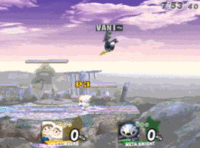
Several of the community consider the Ice Climbers to be "the king and queen of all chain grabs" due to the fact that their unique properties as a two-in-one fighter allows for a variety of infinite chain grabbing options that can combo into KO options. For example, the leading Ice Climber can grab onto one opponent and use the forward throw. In the middle of the throwing animation, the player can gain control of the CPU-controlled Climber, commanding them into performing a spike using forward aerial, or grabbing again with the CPU-controlled Climber. while once again bringing the original, player-controlled Climber in for a new grab. Infinite chain grabs of this nature can be performed at any percent, on any character, on nearly any stage. One hindrance to this strategy is the Ice Climbers' short grabbing range and low traction, making it almost impossible to grab an opponent when they hit the player's shield(s) unless the Ice Climbers powershield the attack.
The Ice Climbers have many different options to perform an infinite chain grab. They can use any combination of forward throw, down throw, and back throw, but each option has different timings for every character. For example, against Meta Knight it is most common for players to infinite using a combination of down throw and back throw, as these two throws have the largest time-windows to achieve a regrab. Against large characters that are difficult to chain grab, like Snake and R.O.B., the down throw can be used in conjunction with the footstool hop and ice shots for another infinite: the hobble. A hobble is performed when the Ice Climbers' down throw sends opponents into the air, the second Ice Climber jumps and footstools the opponent back onto the ground, and as the opponent bounces, the first Ice Climber traps them with an ice shot causing a reset for another grab. The only possible break to a perfectly executed infinite is Brawl's random tripping, which can occur if either climber dashes for any length of time. This can be avoided by only performing infinite chaingrabs while walking. When a chain grab has raised an opponent's damage enough, the most typically used move to KO the opponent is their up smash, if a forward air meteor smash is inapplicable. All of these chain throws can be considered 0-KO combos.
For further two-in-one tricks, it is even possible to de-synchronize or "desync" the CPU-controlled partner by confusing it with erratic movement (such as dash-dancing), putting the player in control of both Climbers for as long as they are capable of maintaining it. Once the partner is desynced, the player can have it perform any move while the main Climber is in the middle of one, providing for all sorts of possible attack strategies that can be exceedingly difficult for opponents to escape from (alternating Blizzard, alternating Ice Shot). While desynced, the partner Climber has restrained movement within an invisible box around the main Climber; should they be separated or removed from this box, the CPU will take over again. This invisible box makes it so that if the player desyncs from the AI so that it charges a smash attack and they start walking or running away, the AI will slide in the player's direction while charging the smash. A unique thing that the player can do when desynced is that if they desync the AI to charge a smash attack, their Belay will cancel the AI's charging sequence and teleport it into the belaying sequence. Such techniques are extremely difficult to perform in combat, even for advanced players, due to the constant string of precise commands required for the Climbers to move/attack as intended. Nevertheless, these techniques are considered the backbone of playing the Ice Climbers at a competitive level.
Changes from Super Smash Bros. Melee
The Ice Climbers have received a mix of buffs and nerfs in the transition from Melee to Brawl, although the duo have received a few noticeable nerfs. Due to the changes in grab-based mechanics, wobbling has been removed, which had formally been a considerable candidate of their competitive viability. Additionally, the loss of wavedashing has also proven to be a hindrance against the Ice Climbers due to their low traction, inhibiting their approach and mobility. This renders their low traction more of a liability, though not the extent of Luigi. The Ice Climbers' damage output has also been lowered, a variety of their moveset have received reductions to their KO potential, and the rest of their grounded moveset have received more ending lag, leaving them more vulnerable to punishes.
However, due to the influence of chain grabbing, the Ice Climbers are considered to be overall buffed. Due to the improvements to their chain grabbing ability, the Ice Climbers are even deadier than in Melee relative to the cast. The player now possesses full control over the following climber during a grab, allowing the player to liberally chain grab and combo out of a grab. In addition, their standing grab is slightly faster and the universal changes to shields makes it easier for the Ice Climbers to grab their opponents. Altogether, the Ice Climbers are one of the only characters in the game who can consistently zero-to-death the entire cast, which is especially beneficial as combos are universally and drastically less deadly and plentiful in Brawl than in Melee due to the introduction of hitstun canceling. The following climber also boasts more artificial intelligence than in Melee, increasing their usefulness and reducing their vulnerability. While the Ice Climbers' grounded mobility is slower, the rest of the cast received the same treatment and most of the cast's attacks that exploited the Ice Climbers' difficulty in sticking together (such as Fox's Shine and Peach's down smash) have been drastically nerfed, making it harder for opponents to play around their grabs and separate them. Lastly, Blizzard is a much more versatile tool than in Melee, and can be a strong tool to edgeguard, apply pressure, rack up damage and allow the Ice Climbers to grab their opponents.
As a result, the Ice Climbers are one of the few characters considered to have been truly buffed from Melee to Brawl, and the duo are widely considered to be the best character behind Meta Knight.
Aesthetics
 As with the rest of the characters in Brawl, the Ice Climbers have aesthetically received a drastic boost in terms of quality, with their parkas possessing increased quality-textures and the white fur on their parkas applying more visible fur. Their skin tone is paler and lighter, their hairstyles have a slightly lighter coloration, their cheeks are less visible, and their gloves have a slightly darker color.
As with the rest of the characters in Brawl, the Ice Climbers have aesthetically received a drastic boost in terms of quality, with their parkas possessing increased quality-textures and the white fur on their parkas applying more visible fur. Their skin tone is paler and lighter, their hairstyles have a slightly lighter coloration, their cheeks are less visible, and their gloves have a slightly darker color.
 Side taunt has been tweaked a bit: the wind that blows behind them is much more visible and its sound effect is much more quieter.
Side taunt has been tweaked a bit: the wind that blows behind them is much more visible and its sound effect is much more quieter. The Ice Climbers have a pair of new alternate costumes: Nana's orange costume is replaced with a blue color to replicate Popo. The first new alternate costume depicts them in white, while the other depicts Nana in black and Popo in grey. The player takes control of Popo in the blue skin and Nana in the new white and black skins.
The Ice Climbers have a pair of new alternate costumes: Nana's orange costume is replaced with a blue color to replicate Popo. The first new alternate costume depicts them in white, while the other depicts Nana in black and Popo in grey. The player takes control of Popo in the blue skin and Nana in the new white and black skins. The Ice Climbers' 4th alternate costume has a darker coloration, and Nana's yellow costume possesses a much darker variant of yellow.
The Ice Climbers' 4th alternate costume has a darker coloration, and Nana's yellow costume possesses a much darker variant of yellow. Nana no longer switches positions on the character selection screen when equipping costumes, where she is the leader instead of Popo.
Nana no longer switches positions on the character selection screen when equipping costumes, where she is the leader instead of Popo.
Attributes
 The Ice Climbers walk slightly faster (0.95 → 0.96).
The Ice Climbers walk slightly faster (0.95 → 0.96). The Ice Climbers dash slightly slower (1.4 → 1.388).
The Ice Climbers dash slightly slower (1.4 → 1.388). The Ice Climbers' air speed is slightly faster (0.7 → 0.7708), especially relative to the returning veterans, going from the 2nd slowest out of 26 to the 5th slowest out of 38.
The Ice Climbers' air speed is slightly faster (0.7 → 0.7708), especially relative to the returning veterans, going from the 2nd slowest out of 26 to the 5th slowest out of 38. As with other returning veterans, the Ice Climbers' falling speed is significantly slower (1.6 → 1.2). Compared to the returning veterans, however, the Ice Climbers fall faster. While this improves their endurance, it worsens their recovery and makes them more vulnerable to combos and chain grabs relative to the cast.
As with other returning veterans, the Ice Climbers' falling speed is significantly slower (1.6 → 1.2). Compared to the returning veterans, however, the Ice Climbers fall faster. While this improves their endurance, it worsens their recovery and makes them more vulnerable to combos and chain grabs relative to the cast. The Ice Climbers' gravity is lower (0.1 → 0.077). While this slightly hinders their vertical endurance, it also makes them less vulnerable to chain grabs.
The Ice Climbers' gravity is lower (0.1 → 0.077). While this slightly hinders their vertical endurance, it also makes them less vulnerable to chain grabs. The Ice Climbers' traction has been unchanged (0.035). Comparing with the returning veterans, however, the Climbers' traction is higher, making it easier for them to punish out of shield, although the duo still remain the 2nd-lowest traction in the game after Luigi. Their traction remains intact on slippery terrain (such as ice), which is even more effective than in Melee as traction has received reductions across the board in Brawl. The duo are also immune to tripping on ice, while the rest of the cast has an increased chance of tripping on ice.
The Ice Climbers' traction has been unchanged (0.035). Comparing with the returning veterans, however, the Climbers' traction is higher, making it easier for them to punish out of shield, although the duo still remain the 2nd-lowest traction in the game after Luigi. Their traction remains intact on slippery terrain (such as ice), which is even more effective than in Melee as traction has received reductions across the board in Brawl. The duo are also immune to tripping on ice, while the rest of the cast has an increased chance of tripping on ice. The Ice Climbers are heavier (88 → 92).
The Ice Climbers are heavier (88 → 92). The Ice Climbers' jumpsquat is longer (3 frames → 4).
The Ice Climbers' jumpsquat is longer (3 frames → 4). Both Ice Climbers can now grab a ledge at the same time, improving their recovery.
Both Ice Climbers can now grab a ledge at the same time, improving their recovery. The partner's artificial intelligence when separated has been increased, now being nearly equivalent to a level-9 CPU.
The partner's artificial intelligence when separated has been increased, now being nearly equivalent to a level-9 CPU. The following climber can now mash out of a shield break.
The following climber can now mash out of a shield break. Several of the partner's attacks now have lower hitlag multipliers, making their attacks harder to DI.
Several of the partner's attacks now have lower hitlag multipliers, making their attacks harder to DI. Stale-move negation no longer affects the partner's attacks when performing the same attack as the leader.
Stale-move negation no longer affects the partner's attacks when performing the same attack as the leader.
 To compensate for this, however, a considerable portion of the partner's attacks now deal less damage (usually around 1%-3% less), resulting in a fair amount of their moveset dealing less damage when together, although the partner's aerials and smash attacks deal more knockback than the leader's for compensation.
To compensate for this, however, a considerable portion of the partner's attacks now deal less damage (usually around 1%-3% less), resulting in a fair amount of their moveset dealing less damage when together, although the partner's aerials and smash attacks deal more knockback than the leader's for compensation.
 The partner now shares the same weight as the leader rather than being heavier, and no longer has passive armor, making them easier to KO.
The partner now shares the same weight as the leader rather than being heavier, and no longer has passive armor, making them easier to KO. The removal of wavedashing has hindered the Ice Climbers' mobility and approach, especially compared to the other returning veterans, although it also hinders the rest of the cast's mobility, making it easier for the Ice Climbers to grab their opponents.
The removal of wavedashing has hindered the Ice Climbers' mobility and approach, especially compared to the other returning veterans, although it also hinders the rest of the cast's mobility, making it easier for the Ice Climbers to grab their opponents. The freeze glitch has been completely removed.
The freeze glitch has been completely removed.
Ground attacks
- Neutral attack:
 Neutral attack's first hit deals more damage (2% → 3%).
Neutral attack's first hit deals more damage (2% → 3%). The move deals more damage overall due to changes to stale-move negation (8% → 11%), assuming both climbers are present).
The move deals more damage overall due to changes to stale-move negation (8% → 11%), assuming both climbers are present). Both hits of neutral attack have more ending lag (FAF 16 → 27 (hit 1), FAF 18 → 20 (hit 2)).
Both hits of neutral attack have more ending lag (FAF 16 → 27 (hit 1), FAF 18 → 20 (hit 2)).
- Forward tilt:
 Forward tilt deals more damage (8% → 9% (solo), 15% → 16% (non-angled with partner) 18% (angled with partner)), although with compensation on the base knockbac of up-angled forward tilt (40 → 30).
Forward tilt deals more damage (8% → 9% (solo), 15% → 16% (non-angled with partner) 18% (angled with partner)), although with compensation on the base knockbac of up-angled forward tilt (40 → 30). Non-angled forward tilt has more base knockback (26 → 30).
Non-angled forward tilt has more base knockback (26 → 30). The partner's forward tilt has less hitlag (1x → 0.5x).
The partner's forward tilt has less hitlag (1x → 0.5x). It has more startup lag (frame 6 → 9) and ending lag (FAF 28 → 32).
It has more startup lag (frame 6 → 9) and ending lag (FAF 28 → 32).
- Up tilt:
 Up tilt now consists of three hitboxes, which are larger than the previous two (4.6/3.5u (hits 1-6), 5.4/3.9u (hit 7) → 4/3/7/4/4/8u)).
Up tilt now consists of three hitboxes, which are larger than the previous two (4.6/3.5u (hits 1-6), 5.4/3.9u (hit 7) → 4/3/7/4/4/8u)). It has a lower hitlag multiplier (1x → 0.5x (leader loop hits/partner final hit), 0.3x (partner)), making it connect more reliably and conistently, especially against grounded opponents.
It has a lower hitlag multiplier (1x → 0.5x (leader loop hits/partner final hit), 0.3x (partner)), making it connect more reliably and conistently, especially against grounded opponents. Up tilt's final hit deals less damage (7% → 4%) with no compensation on its knockback.
Up tilt's final hit deals less damage (7% → 4%) with no compensation on its knockback. It has more ending lag (FAF 42 → 48).
It has more ending lag (FAF 42 → 48).
- Down tilt:
 Down tilt deals more damage (4-5% → 6%).
Down tilt deals more damage (4-5% → 6%). It has more base knockback (30 → 40).
It has more base knockback (30 → 40). It now sends opponents at a semi-spike angle as opposed to a more vertical angle (70° → 20°). While this hinders its combo potential, it significantly improves its edgeguarding potential (which is overall more useful due to the introduction of hitstun canceling).
It now sends opponents at a semi-spike angle as opposed to a more vertical angle (70° → 20°). While this hinders its combo potential, it significantly improves its edgeguarding potential (which is overall more useful due to the introduction of hitstun canceling). It also connects much more consistently when both climbers are present due to the expansion of hitlag.
It also connects much more consistently when both climbers are present due to the expansion of hitlag. It has more ending lag (FAF 29 → 31).
It has more ending lag (FAF 29 → 31).
- Dash attack:
 Dash attack deals less damage (9% → 6%), although with compensation on its knockback scaling (40 → 60).
Dash attack deals less damage (9% → 6%), although with compensation on its knockback scaling (40 → 60). It has more ending lag (FAF 38 → 41).
It has more ending lag (FAF 38 → 41).
- Forward smash:
 Forward smash has less startup lag (frame 13 → 12).
Forward smash has less startup lag (frame 13 → 12). The sourspot deals more damage (10% → 12%).
The sourspot deals more damage (10% → 12%). The partner's forward smash has more knockback scaling (105 → 118), improving its KO potential.
The partner's forward smash has more knockback scaling (105 → 118), improving its KO potential. The sweetspot deals less damage (14% → 13%).
The sweetspot deals less damage (14% → 13%). Both hits have less base knockback (40 → 30), slightly hindering their KO potential.
Both hits have less base knockback (40 → 30), slightly hindering their KO potential. It has slightly increased ending lag (FAF 47 → 48).
It has slightly increased ending lag (FAF 47 → 48).
- Up smash:
 Up smash has less startup lag with a longer duration (frames 14-18 → 13-18)
Up smash has less startup lag with a longer duration (frames 14-18 → 13-18) Up smash has less knockback scaling (128 → 105 (leader), 113 (partner)), hindering its KO potential.
Up smash has less knockback scaling (128 → 105 (leader), 113 (partner)), hindering its KO potential. It now has a sourspot, which deals 9%.
It now has a sourspot, which deals 9%. It has more ending lag (FAF 44 → 50).
It has more ending lag (FAF 44 → 50).
- Down smash:
 Down smash can deal more maximum damage since it now has two hits (20%-22% → 36%-40% (both climbers)).
Down smash can deal more maximum damage since it now has two hits (20%-22% → 36%-40% (both climbers)). It now launches opponents vertically (361° → 60°/83°).
It now launches opponents vertically (361° → 60°/83°). Down smash has more startup lag (frame 6 → 9) and ending lag (FAF 36 → 45).
Down smash has more startup lag (frame 6 → 9) and ending lag (FAF 36 → 45). It deals less knockback (50 (base), 110 (scaling) → 30/105 (leader), 30/113 (partner)), hindering its KO potential.
It deals less knockback (50 (base), 110 (scaling) → 30/105 (leader), 30/113 (partner)), hindering its KO potential. It now has a sourspot, which deals 10%, although it launches opponents at a more vertical angle to compensate.
It now has a sourspot, which deals 10%, although it launches opponents at a more vertical angle to compensate.
Aerial attacks
 Neutral, back and up aerials have less landing lag (20 frames → 15 (neutral/back), 32 frames → 30 (up)). Due to the removal of L-canceling, however, their landing lag were not fully compensated.
Neutral, back and up aerials have less landing lag (20 frames → 15 (neutral/back), 32 frames → 30 (up)). Due to the removal of L-canceling, however, their landing lag were not fully compensated. Due to their slower falling speed, the Ice Climbers can now perform a pair of aerials in a short hop by using either back aerial or up aerial.
Due to their slower falling speed, the Ice Climbers can now perform a pair of aerials in a short hop by using either back aerial or up aerial.- Neutral aerial:
 Neutral aerial can now auto-cancel in a short hop due to the Ice Climbers' slower falling speed.
Neutral aerial can now auto-cancel in a short hop due to the Ice Climbers' slower falling speed. The partner's neutral aerial deals much less damage (8% → 5%), although with compensation on knockback (100 → 128).
The partner's neutral aerial deals much less damage (8% → 5%), although with compensation on knockback (100 → 128). It deals less damage (8% → 7%), hindering its KO potential with a solo-climber.
It deals less damage (8% → 7%), hindering its KO potential with a solo-climber.
- Forward aerial:
 Forward aerial deals more damage (11%/10%/9% → 12% (solo), 20% → 24% (clean with both climbers)), improving its KO potential despite the leader's forward aerial having lower knockback scaling (100 → 95), although the base knockback on the partner's sweetspot was compensated (40 → 20).
Forward aerial deals more damage (11%/10%/9% → 12% (solo), 20% → 24% (clean with both climbers)), improving its KO potential despite the leader's forward aerial having lower knockback scaling (100 → 95), although the base knockback on the partner's sweetspot was compensated (40 → 20). It sends opponents at a more horizontal angle (70° → 40°), improving its edgeguarding and KO potential.
It sends opponents at a more horizontal angle (70° → 40°), improving its edgeguarding and KO potential. The leader's forward aerial can no longer meteor smash, meaning that only the partner's forward aerial can meteor smash.
The leader's forward aerial can no longer meteor smash, meaning that only the partner's forward aerial can meteor smash. It has a shorter duration (frames 19-22 → 19-20).
It has a shorter duration (frames 19-22 → 19-20).
- Back aerial:
 Back aerial deals more knockback (30 (base), 100 (scaling) → 25/107 (leader), 25/128 (partner)), improving their KO potential.
Back aerial deals more knockback (30 (base), 100 (scaling) → 25/107 (leader), 25/128 (partner)), improving their KO potential. It no longer has a sweetspot that deals more damage (12% → 11%) and knockback (30 (base), 110 (scaling) → 25/107), although with compensation on knockback of the remaining hitboxes.
It no longer has a sweetspot that deals more damage (12% → 11%) and knockback (30 (base), 110 (scaling) → 25/107), although with compensation on knockback of the remaining hitboxes.
- Up aerial:
 Clean up aerial deals more damage (8/9% → 10%), although with compensation on knockback (10 (base), 140 (scaling) → 20/120 (leader), 20/142 (partner)) and retaining its sourspot that deals 9%.
Clean up aerial deals more damage (8/9% → 10%), although with compensation on knockback (10 (base), 140 (scaling) → 20/120 (leader), 20/142 (partner)) and retaining its sourspot that deals 9%. The leader's sourspotted up aerial deals less knockback, although with compensation on the knockback of the partner's up aerial (10 (base), 140 (scaling) → 20/120 (leader), 20/142 (partner)).
The leader's sourspotted up aerial deals less knockback, although with compensation on the knockback of the partner's up aerial (10 (base), 140 (scaling) → 20/120 (leader), 20/142 (partner)).
- Down aerial:
 Down aerial no longer has set knockback (36 (set), 110 (scaling) → 40 (base), 90 (leader scaling), 130 (partner scaling)). This gives the attack KO potential around 170%.
Down aerial no longer has set knockback (36 (set), 110 (scaling) → 40 (base), 90 (leader scaling), 130 (partner scaling)). This gives the attack KO potential around 170%. It now functions as a stall-then-fall, making it risky to use offstage, but giving it recovery usage via down air stall.
It now functions as a stall-then-fall, making it risky to use offstage, but giving it recovery usage via down air stall. It deals less damage (9% → 8%).
It deals less damage (9% → 8%). It has more startup lag with a shorter duration (frames 3-52 → 9-51).
It has more startup lag with a shorter duration (frames 3-52 → 9-51). It has much more landing lag (25 frames → 42).
It has much more landing lag (25 frames → 42).
Throws/other attacks
- Grabs:
 Standing grab has less startup lag (frame 7 → 6).
Standing grab has less startup lag (frame 7 → 6). Dash grab has more startup lag (frame 7 → 8).
Dash grab has more startup lag (frame 7 → 8). The partner is now controlled by the player rather than the AI when grabbing an opponent, enabling the player to effectively control the direction in which to throw the grabbed opponent, significantly extending their chain grabbing ability and allowing for easy KO setups. This means that despite the removal of wobbling, the Ice Climbers can still effectively zero-to-death the entire cast which, while more difficult to perform, it still remains inescapable and overall has more versatility.
The partner is now controlled by the player rather than the AI when grabbing an opponent, enabling the player to effectively control the direction in which to throw the grabbed opponent, significantly extending their chain grabbing ability and allowing for easy KO setups. This means that despite the removal of wobbling, the Ice Climbers can still effectively zero-to-death the entire cast which, while more difficult to perform, it still remains inescapable and overall has more versatility.
- Pummel:
 Pummel deals less damage (3% → 1%) without full compensation on speed (frame 26 → 19).
Pummel deals less damage (3% → 1%) without full compensation on speed (frame 26 → 19).
 All throws excluding down throw deal less damage (11% → 8% (forward), 7% → 6% (back), 11% → 6% (up)).
All throws excluding down throw deal less damage (11% → 8% (forward), 7% → 6% (back), 11% → 6% (up)).- Back throw:
 Back throw is now a true infinite chain grab. It can also be used in conjunction with footstools and Ice Shot to lock the opponent.
Back throw is now a true infinite chain grab. It can also be used in conjunction with footstools and Ice Shot to lock the opponent.
- Up throw:
 Up throw has more base knockback (110 → 120), although it is still far too weak to KO effectively.
Up throw has more base knockback (110 → 120), although it is still far too weak to KO effectively.
- Down throw:
 Down throw deals much less base knockback, but much more knockback scaling (70 (base), 40 (scaling) → 30/100). When combined with the removal of DI against non-tumbling attacks, this makes the attack more reliable for chain grabbing both with or without the partner.
Down throw deals much less base knockback, but much more knockback scaling (70 (base), 40 (scaling) → 30/100). When combined with the removal of DI against non-tumbling attacks, this makes the attack more reliable for chain grabbing both with or without the partner. It no longer requires the asisst of Blizzard or down aerial to string chain grabs due to the greater degree of control the player has over the partner.
It no longer requires the asisst of Blizzard or down aerial to string chain grabs due to the greater degree of control the player has over the partner.
Special moves
 The Ice Climbers have different voice-clips when performing their special moves, and all special moves have different and more aesthetic sound effects.
The Ice Climbers have different voice-clips when performing their special moves, and all special moves have different and more aesthetic sound effects.- Ice Shot:
 Ice Shot is no longer absorbable.
Ice Shot is no longer absorbable. Ice Shot is capable of being B-reversed.
Ice Shot is capable of being B-reversed. Ice shot deals less damage (5% → 3%).
Ice shot deals less damage (5% → 3%). The hammer no longer has a hitbox, heavily reducing the move's maximum damage output (26% → 6%) and increasing the move's startup lag (frame 15 → 17).
The hammer no longer has a hitbox, heavily reducing the move's maximum damage output (26% → 6%) and increasing the move's startup lag (frame 15 → 17). Landing with Ice Shot from the air now results in an animation where the ice Climbers crash land on their rears. The landing lag remains intact, however.
Landing with Ice Shot from the air now results in an animation where the ice Climbers crash land on their rears. The landing lag remains intact, however.
- Squall Hammer:
 Squall Hammer now inflicts soft snowflakes of ice if both Ice Climbers are present.
Squall Hammer now inflicts soft snowflakes of ice if both Ice Climbers are present. Squall Hammer connects much more consistently due to the looping hits dealing much less knockback scaling (130 → 80) and launching at lower angles (70° → 30°), making it easier to rack up damage with it.
Squall Hammer connects much more consistently due to the looping hits dealing much less knockback scaling (130 → 80) and launching at lower angles (70° → 30°), making it easier to rack up damage with it.
 In addition, Squall Hammer now concludes a stronger finisher, which deals drastically more knockback (5 (base), 80 (scaling) → 50/140) and more damage (4% → 6%), allowing Squall Hammer to KO at 130%-140% in comparison to Melee, where it was unable to KO until about 400%-600%.
In addition, Squall Hammer now concludes a stronger finisher, which deals drastically more knockback (5 (base), 80 (scaling) → 50/140) and more damage (4% → 6%), allowing Squall Hammer to KO at 130%-140% in comparison to Melee, where it was unable to KO until about 400%-600%.
 The looping hitboxes deal more consistent damage, though it is still inconsistent (1-4% → 2-3%).
The looping hitboxes deal more consistent damage, though it is still inconsistent (1-4% → 2-3%). Squall Hammer now deals up to a total of 8 hits instead of 11, which drastically halves Squall Hammer's maximum damage output (44% → 25%).
Squall Hammer now deals up to a total of 8 hits instead of 11, which drastically halves Squall Hammer's maximum damage output (44% → 25%). Squall Hammer no longer grants vertical distance unless both Ice Climbers are present, hindering a solo-climber's recovery.
Squall Hammer no longer grants vertical distance unless both Ice Climbers are present, hindering a solo-climber's recovery.
- Belay:
 Belay now functions as a tether recovery when performed close to a ledge; the partner will initially shoot to the ledge, then the leader will immediately reach up to it.
Belay now functions as a tether recovery when performed close to a ledge; the partner will initially shoot to the ledge, then the leader will immediately reach up to it. A single Ice Climber's Belay also covers slightly more distance, allows them to move left or right, and allows the climber to turn around, no longer leaving the climber helpless if facing from the ledge.
A single Ice Climber's Belay also covers slightly more distance, allows them to move left or right, and allows the climber to turn around, no longer leaving the climber helpless if facing from the ledge. The following climber travels less horizontal distance when using Belay.
The following climber travels less horizontal distance when using Belay. Belay has more landing lag (25 frames → 30).
Belay has more landing lag (25 frames → 30).
- Blizzard:
 Blizzard deals consistent damage (1-2% → 2%) and it connects more reliably. It also freezes opponents significantly sooner and more reliably. It can now also be B-reversed.
Blizzard deals consistent damage (1-2% → 2%) and it connects more reliably. It also freezes opponents significantly sooner and more reliably. It can now also be B-reversed.
- Iceberg:
 As with the rest of the entire roster, the Ice Climbers now have a Final Smash: Iceberg. The duo high-five each other (if solo, the leading Ice Climber spins and raises their hamme up), summoning an enormous iceberg up from the ground that covers almost the entire stage, damaging and potentially freezing opponents making contact with it. After enough moments, the Iceberg will slowly
As with the rest of the entire roster, the Ice Climbers now have a Final Smash: Iceberg. The duo high-five each other (if solo, the leading Ice Climber spins and raises their hamme up), summoning an enormous iceberg up from the ground that covers almost the entire stage, damaging and potentially freezing opponents making contact with it. After enough moments, the Iceberg will slowlyThe Ice Climbers now have access to the Iceberg glitch.
Moveset
- Although the Ice Climbers have among the lowest traction in the game, their traction is completely unaffected by slippery terrain, such as ice.
Note: This assumes that both Ice Climbers are present.
| Name | Damage | Description | ||
|---|---|---|---|---|
| Neutral attack | 3% (leader), 2% (partner) | A pair of one-two combo swipes horizontally and vertically, respectively. An impressive get-off-me too with good damage for a neutral attack to boot. The first hit can jab lock and space beginning at 85%. | ||
| 4% (leader), 2% (partner) | ||||
| Forward tilt | ↗ | 9% (both) | A short-straight horizontal hammer-swipe in front of themselves. Can be angled up or down, with the partner dealing more damage if angled at either directions. It is effective at spacing beginning at 25%, while it has surprising knockback growth for a forward tilt, being able to KO middleweights at around 135% by the edge of Final Destination, but can KO most characters as early as 80-90% by the edge on stages with low horizontal blast zones. Aside from KOing, it is also useful for edgeguarding and gimping vulnerable recoveries, especially when angled down. | |
| → | 9% (leader), 7% (partner) | |||
| ↘ | 9% (both) | |||
| Up tilt | 1% (hits 1-6), 4% (hit 7 [leader]), 3% (hit 7 [partner]) | Twirl their hammers over their heads, creating a lingering hitbox that deals multiple hits. It inflicts the maximum of 19% if all collective hits connect, and although it is possible to SDI out of each hit, it is fairly difficult to do so when the partner is present, making it an efficient anti-air and juggling tool that is one of their best damage-racking tools and combo starters/extenders in the duo's kit. Can often lead to a grab or an aerial combo at low percents, or Belay at high precents. A useful combo starter that can begin a chain of up aerials. | ||
| Down tilt | 6% (leader), 4-5% (partner) | Sweep their hammers across the ground in front of themselves in an arc. It is typically useful for gimping recoveries (such as Snake's Cypher) and edgeguarding. A steep semi-spike that functions exceptionally well as both a burst poking and shield stabbing option in neutral, as well as an edgeguarding and KOing option near 120% by the edge, thanks to its quick start-up lag, decent range, and low ending lag. | ||
| Dash attack | 6% (leader), 4% (partner) | Leap forward while ramming their hammers in front of themselves. It has noticeable start-up lag for a dash attack; however, despite its high ending lag, its horizontal momentum allows it to cross-up shielding opponents (although the Ice Climbers must be close to a shielding opponent precisely in order to cross-up a shield). It is useful for approaching and initiating free air-based combos due to its vertical knockback; however, despite the move's moderately high lag, its poor knockback prevents it from KOing until well past 200%. | ||
| Forward smash | 13%/12% (leader), 10%/9% (partner) | Lift their hammers over their heads, then smashes them straight down in an arc. Regardless if both Ice Climbers or an individual climber connect the move, it is among the strongest forward smashes in Brawl and one of the duo's most viable KOing options in their kit, KOing Mario at around 109% at the center of Final Destination without being charged. Despite its power, it is also quite quick for a comparatively powerful and decent-ranged smash attack. Aside from KOing, it is useful for finishing chain grabs, as well as leading to a guaranteed KO off grab releases. By extension, it is also reliable at edgeguarding and gimping, as well as easily racking up damage early. It has a comparable mechanic to Marth's forward smash; it inflicts less damage if the opponents hit the hilt of the hammers. In turn, it inflicts more damage if hit at the tip. Originates from their classic attacking animation from Ice Climber. | ||
| Up smash | 11%/9% (leader), 9%/8% (partner) | Swing their hammers vertically in a straight arc over their heads. Good as a finisher from chain grabs. It inflicts more damage if the opponent hit the head of the hammer. It is one of the duo's most viable KOing options in their kit, KOing Mario at around 112% on Final Destination without being charged up. However, it has mediocre base knockback, thus making it more suitable in attempting KOs later instead of earlier. It is useful for catching an opponent's landing, being an anti-air and juggling tool that easily racks up damage early and initiate aerial combos. | ||
| Down smash | 12%/10% (leader), 9%/8% (partner) | Spin around, sweeping the ground with their hammers in a considerable circle. Although difficult to pull off, it can hit up to four times depending on the size of the opponent's hurtbox (dealing up to 42%), although this is also heavily dependent on the opponent's SDI. This mostly occurs against sizable opponents, like Bowser and King Dedede. It is the 2nd most-damaging down smash in Brawl, surpassed by only Lucas by 5%. Even though it is the weakest among the rest of duo's smash attacks, it is still a solid and reliable KOing option in neutral, as it KOs middleweights even earlier than 105% at the center of Final Destination upon connecting all four hitboxes. Because of its multi-hit nature, however, it is one of the best damage-rackers in the entire game, especially when beginning battles. This also allows it to be easily exploited for speedruns in certain modes (such as Boss Battles), like other quick and damaging down smashes, such as Mr. Game & Watch's down smash and Olimar's up smash (with all kinds of Pikmin, excluding white ones). As such, it is more suitable at damage-racking than KOing and is one of the most versatile smash attacks in the entire game. It inflicts more damage if the opponent hits the tip of their hammers. | ||
| Neutral aerial | 7% (leader), 5% (partner) | Spin in a circle with their hammers outstretched. Good for aerial spacing and approaching, as well as edge-guarding and gimping certain recoveries. The late hitboxes are useful for locking and leading to guaranteed combos (especially when landing) at lower precentages, whereas the early ones are useful for KOing at later precents, thus killing middleweights at around 135% by the edge of Final Destination. It is also effective for desynced combos and is one of the duo's best out of shield options in their arsenal, along with being a serviceable get-off-me tool due to its quick start-up lag, respectable knockback and low ending lag. | ||
| Forward aerial | 12% (leader), 12% (partner sweetspot), 7% (partner sourspot) | Rear their hammers back, then perform a double-axe handle slam with them straight down in an arc. Although it has slow start-up (especially compared to their other aerials) and high ending lag, its landing lag is not as noticeable compared to its power. The partner can meteor smash opponents if the move is sweetspotted, which is powerful enough to KO as early as 70%. In turn, the sourspotted hitboxes are strengthened enough to KO Mario at about 105% by the edge of Final Destination. Despite its animation, the hitboxes are deceptively disjointed to the point that the opponent will still get hit even if their hammers do not touch them. It can also gimp vulnerable recoveries that lack enough coverage. Altogether, this makes it a viable approaching and edgeguarding option, as well as one of the duo's most viable KOing options in their kit and among the strongest aerial attacks in Brawl. Originates from their classic aerial attacking animation from Ice Climber. | ||
| Back aerial | 11% (leader), 8% (partner) | Perform a backfist with their hammers. It has excellent knockback growth, which make it a viable KOing option. Its clean hitbox KOs middleweights at around 106% while near the edge of Final Destination, which is around the same KO percentages of the Ice Climbers' forward aerial. It also boasts good range due to its disjointed hitbox and its animation makes it unpredictable, which makes it a viable edge-guarding and 2-framing option, and makes it effective for a wall of pain, as well as a good approaching option in conjunction with a reverse aerial rush. It can also stage spike with proper usage, making it especially deadly off-stage. Both hits are extremely safe on shield, with the secondary climber's hit being one of the few moves that is positive on shield. | ||
| Up aerial | 10%/9% (leader clean), 7% (leader late), 7%/6% (partner clean), 5% (partner late) | Thrust their hammers straight overhead. Similar to their up tilt, but with only a single hitbox per Ice Climber. It has a relatively long duration and has the least amount of ending lag out of the duo's aerials. Like their back aerial, the Ice Climbers can easily perform the move twice in a short hop, although it has high landing lag. It is an excellent juggling tool that can combo into itself at lower percents. It can also create a lot of shield pressure if the opponent is on a platform and can be effective when combined with desynching. It can KO middleweights at around 125% on Final Destination. It is overall their best aerial attack, although if the duo are initiating their powerful chain grabs, the duo have far superior options, such as Blizzard, so up aerial is primarily useful as a pressuring tool from below. | ||
| Down aerial | 8% (leader), 5% (partner) | Hold their hammers below themselves and falls downwards. A stall-then-fall, with the stall being almost unnoticeable. Has considerable landing lag if not auto-cancelled. Additionally, it is unable to meteor smash, unlike most attacks of its kind. The hitbox covers most of the Ice Climbers' underside, making it good for punishing opponents who attempt to juggle. It can be effectively used out of a short hop to attack opponents directly in front of the Ice Climbers, especially out of shield. While it can potentially cause the Ice Climbers to self-destruct while using it off-stage, their effective recovery, combined with it having the lowest ending lag of the Ice Climbers' aerials and the move traveling slower than the other stall-then-falls makes this unlikely. It can KO middleweights at around 170% on Final Destination, while the partner's down aerial is a steep semi-spike that can KO middleweights at around 165% at the center of Final Destination. | ||
| Grab | — | Each Ice Climber reaches out with their free hand. All of the Ice Climbers' grabs are extremely quick, but are burdened with short range. | ||
| Pummel | 1% | A headbutt. The leader pummels the opponent, whereas the player has some control over the partner while pummeling. | ||
| Forward throw | 3% (hit 1), 5% (throw) | A hockey shot. Its moderately high base knockback makes it a viable option for tech-chasing and forcing the opponent offstage to start edgeguards. It can KO at very high precents near the edge. If the player walks slightly forward with the partner before using this throw, they can regrab the opponent again right after using the attack, making this throw a chain grab. | ||
| Back throw | 6% | The leader heaves the opponent behind themselves in an arc, bouncing them off the ground. It is a zero-to-death chain grab in conjunction with down throw. | ||
| Up throw | 2% (hit 1), 4% (throw) | Tosses the opponent in the air, then bashes them upwards with their hammer. It has the highest base knockback and the weakest knockback scaling of all up throws in Brawl. This allows it to notably allows quick access to juggling with up aerial and leads to various followups at lower precents, while it can KO at very high precents while nearing the upper blast zone. However, it lacks KO potential onstage due to its aforementioned minimal knockback growth, not KOing until roughly 469%. | ||
| Down throw | 6% | A powerbomb. It is effective as an infinite chain grab with good timing if both Ice Climbers participate, especially in conjunction with back throw, leading to a zero-to-death. Additionally, it also functions as a versatile combo starter, especially if desynced. It can also KO at very high precents. | ||
| Floor attack (front) | 6% | The Ice Climbers spin 360°, thrusting their hammers around themselves while getting up. | ||
| Floor attack (back) | 6% | The Ice Climbers sweep their hammers in quick arcs from back to forth while getting up. | ||
| Floor attack (trip) | 5% | The Ice Climbers sweep their hammers in a straight line while getting up in a similar manner to their back floor attack. | ||
| Edge attack (fast) | 8% (hammer), 6% (body) | The Ice Climbers climb up and slam their hammers in front of themselves in a straight line. | ||
| Edge attack (slow) | 10% (hammer), 8% (body) | The Ice Climbers hunch over, swiping their hammers straight forward while climbing up. It has disproportionately long range for an edge attack. | ||
| Neutral special | Ice Shot | 1-3% | Each Ice Climber summon a small stalagmite of ice and knock it straight forward with their hammer, causing it to slide along the ground, gradually shrinking as it travels. It bounces off walls and shields. Unlike most projectiles, the ice functions more like a container or soccer ball in that the incoming projectile is completely stop, allowing the Ice Climbers to counter most projectile-spamming playstyles more easily. At extremely high percents, it can also freeze opponents, allowing the usage of setups or reads. It stuns the opponent long enough to make it viable for edgeguarding or gimping vulnerable recoveries. When performed in midair, the Ice Climbers will gain a slight boost in the air, but it will only work once before landing on the ground. | |
| Side special | Squall Hammer | 2-3% (loop) | The Ice Climbers stand back-to-back while spinning around an axis with their hammers outstretched, hitting opponents multiple times. The attack is concluded with them ramming their hammers upward, which launches the opponents upward. By repeatedly tapping the special input, the Ice Climbers will rise in the air, allowing them to recover. This, however, also renders them helpless after usage. If a solo-climber is present, the move inflicts less damage and reduced knockback, and gains less height. Squall Hammer is a prime key factor as a method to begin desyncs, and can trap opponents between each Ice Climber once a desync is achieved. It covers impressive horizontal distance in a short and quick amount of time (covering nearly the full length of Final Destination), allowing them to alleviate their poor approach and overall slow mobility. The final hit is strong enough to KO middleweights at around 159% near the top blast zones on Final Destination. | |
| Up special | Belay | 16% | The leading Ice Climber flings the partner the air with a rope at a considerable height, slamming into opponents during the process. After covering enough distance, the partner pulls the leader upwards at an even greater distance. If nearing a ledge, the partner will immediately target it, and then proceed to pull the leader to the ledge as well. The partner gains invincibility upon startup and the period the hitbox is out until it dissipates, allowing for a safe recovery for both Ice Climbers. This also lets the Ice Climbers perform a pseudo-counterattack against almost all attacks that hit the Ice Climbers during startup, which makes it good for interrupting aerial approaches or attacks. Additionally, the following Ice Climber possesses a hitbox that deals powerful vertical knockback and high damage, dealing enough knockback to KO grounded middleweights at 140% on Final Destination, though it is rather difficult to use as a combo finisher due to the difficulty of aiming the partner. Without a partner, the move will grant essentially no distance. In addition, if the partner collides with an opponent or the hitbox gets out-prioritized, Belay's distance will reduce, similar to PK Thunder 2. Each Ice Climber becomes helpless after Belay. | |
| Down special | Blizzard | 1-2% | The Ice Climbers blow a stream of frigid air from their palms in front of themselves, potentially freezing opponents. If using Blizzard on a frozen opponent, they will remain frozen for a longer duration. If performed in the air while both Ice Climbers are present, this move can deal a maximum of 31.5%. As the name implies, it freezes opponents in their tracks, making it reliable for setups and followups. Using the attack while an opponent is already frozen increases the freeze-time slightly and can allow the duo to make space between them and their opponent if need be, or tack on extra damage while frozen. Specifically, this move is especially useful when edgeguarding or ledge trapping, as freezing an opponent near the edges of a stage can make it easy to nudge them off and near the lower blast zone without any means to escape or recover easily, although the opponent can easily nudge out of the ice by button mashing. In addition, Blizzard is also susceptible to SDI. It also has priority over some other projectiles and can cancel them if the two collide. When the move is performed on the ground, the partner will shoot in the direction opposite of the leader. | |
| Final Smash | Iceberg | 2% (hit), 5% (frozen) | The Ice Climbers high-five each other and raise their arms up, summoning a rotating and giant iceberg to rise up from the center of the stage. If only a single Ice Climber initiates the Final Smash, the leading Ice Climber spins, lifts their hammer up while raising it. Touching the iceberg results in freezing damage, and potentially becoming frozen. Being frozen when pushed off the edge can lead to a quick KO, as the frozen opponents falls to the lower blast zone with full speed. The size of the iceberg is proportionate to the size of the stage; the larger the stage, the larger the iceberg. However, damage can be avoided by edge-hanging through the duration of the move. The iceberg will also become smaller if it is attacked by opponents. Eventually, Iceberg will slowly descend from the stage. The Ice Climbers also have access to the Iceberg glitch. | |
Stats
| Stats | Weight | Dash speed | Walk speed | Traction | Air friction | Air speed | Air acceleration | Gravity | Falling speed | Jumpsquat | Jump Height | Double jump Height |
|---|---|---|---|---|---|---|---|---|---|---|---|---|
| Value | 92 | 1.4 – Initial dash 1.388 – Run |
0.96 | 0.035 | 0.015 | 0.7708 | 0.01 – Base 0.08 – Additional |
0.077 | 1.2 – Base 1.68 – Fast-fall |
4 | 34.69501461 - Base ? - Short hop |
? |
Announcer call
English
Wii Remote selection sound
- Both Ice Climbers say "Youp!" while a sound of them performing Ice Shot is heard.
On-screen appearance
- The Condor flies in with them hanging off its feet. The Ice Climbers jump off while high-fiving each other, and the Condor flies off.
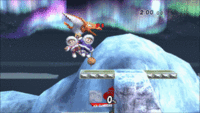
|
|---|
Taunts
- Up taunt: The Ice Climbers set down their hammers and jump excitedly three times before picking them back up. In the Ice Climber NES game, this is the victory celebration of the Ice Climbers during the results screen (albeit without the flag).
- Side taunt: The duo point their hammers diagonally upward and shout "Yup!" in triumph as wind blows behind them, in a similar manner to Ness' side taunt. This animation is identical to in Melee, only with different sound effects.
- Down taunt: The duo dance playfully in a circle, similar to King Dedede's down taunt and Yoshi's up taunt.
| Up taunt | Side taunt | Down taunt |
|---|---|---|
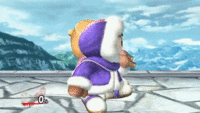
|
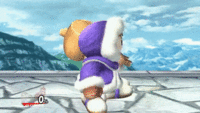
|
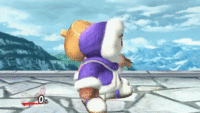
|
Idle poses
- Twirl their hammers.
- Looks curiously to their left side with a concerned expression.
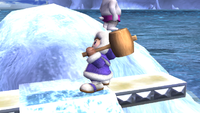 |
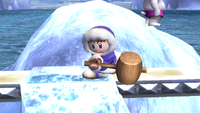
|
|---|
Crowd cheer
| English | Japanese | |
|---|---|---|
| Cheer | ||
| Description | Na-Na! Po-po | Ice-cli-mer! |
| Pitch | High female, then Deep male | Group chant |
- In the NTSC-U and PAL versions, when playing as Nana, the Back sound of the menu plays in lieu of the crowd chant.
- The fact that the crowd chant changes (albeit in a glitchy manner) depending on which Climber is leading the pair might indicate that the lead Climber's name was intended to be chanted first by the crowd.
Victory poses
- Up: Both nod and high-five one another, chanting "Yup!" before facing the screen while smiling.
- Left: The Ice Climbers jump indefinitely up and down with joy. Based on their victory animation during the results screen in the Ice Climber NES game, similar to their up taunt.
- Right: Nana hides behind Popo, only showing her face as Popo shifts from left to right while his arms are positioned next to his hips.
| Up | Left | Right |
|---|---|---|
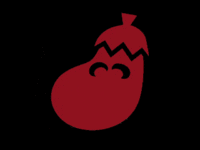
|

|

|
In competitive play
Notable players
- See also: Category:Ice Climbers players (SSBB)
9B - Widely considered the best Ice Climbers player in the world and one of the best players in Japan along with Edge, notably winning SKTAR 3.
DeLux - Placed 5th at WHOBO 5.
ESAM - Considered one of the best players in the United States during the game's later stages; although famous primarily for his Pikachu, has used an Ice Climbers co-main to great success, defeating players such as Kakera and ZeRo using them.
Kakera - Known as one of the top players in Japan, placed 5th at Apex 2012.
lain - A nationally dominant player during his peak from 2009-2010.
Miyacchi - Defeated players such as 9B, Smasher, Nagahari, Earth, OCEAN, Suinoko, Shu, Kei and Masashi.
Nakat - Quickly rose as a top Ice Climbers player in 2013, with a 4th place at SKTAR 2 and wins over Mew2King, Anti, Nairo, and ZeRo.
Vinnie - A nationally dominant player in the later stages of Brawl's life, after switching to Ice Climbers from Mr. Game & Watch.
Yunon - Defeated players such as Shu, Kuroobi, and RAIN.
Tier placement and history
In the first year of Brawl's metagame, the Ice Climbers were ranked as high-tier characters, but were not especially considered a dominant force, given how weak Popo alone is after Nana dies, and their powerful grab tactics were unrecognized at the time. However, Ice Climbers players soon began to utilize their infinite chain grabs, giving them an extremely powerful zero-to-death option against any other character, which shot them up the tier list. Players found dealing with this difficult, as it completely changed the way players fought the Ice Climbers, with the matchup now revolving around avoiding getting grabbed at all, and the Ice Climbers were able to completely shut down characters who lacked effective means to avoid grabs or separate the Ice Climbers. lain became the character's first top level player in 2009 and 2010, achieving multiple major top 8 placements, such as Apex 2009 and S.N.E.S.. This resulted in the Ice Climbers being considered uncontested top-tiers by the Brawl Back Room's the fourth tier list where they ranked 5th, just short of two years after Brawl's international release. However, the Ice Climbers were held back by their relative lack of top representation compared to other top-tiers, and lain was never able to win a major over other top-tier mains. Additionally, the existence of numerous extremely unfavorable stage counterpicks kept the Ice Climbers in check, preventing them from becoming truly dominant. In the earlier Brawl metagame, multiple stages with scrolling platforms and hazards, such as Rainbow Cruise, Brinstar, and Norfair, were available as counterpicks; these stages favored more air-based gameplay and made it much more difficult for the Ice Climbers to complete a zero-to-death chain grab without getting interrupted by the stage.
As Brawl's metagame further refined, the Ice Climbers' tournament presence continued to grow. The Ice Climbers' worst stages also happened to be Meta Knight's strongest stages; as Meta Knight's dominance over the Brawl scene continued to grow, Rainbow Cruise, Brinstar, and Norfair eventually were banned in all Meta Knight-legal tournaments due to his unmatched aerial prowess on those stages. The other two stages with more minor moving platforms and hazards, Halberd and Delfino Plaza, also became more frequently banned due to Meta Knight's dominance there, and typically only one of these stages was available as a counterpick, which gave Ice Climbers mains the opportunity to play around this with a stage ban. These factors allowed the Ice Climbers to truly shine in the Brawl scene. Although lain became inactive, a new wave of even better Ice Climbers players arose from 2011 to 2014. 9B, Vinnie, ESAM, Kakera, and NAKAT quickly became some of the biggest tournament threats in both North America and Japan, achieving multiple first place victories at events such as SumabatoX 6, SKTAR 3, and the MK-banned WHOBO 4 and WHOBO 5; 9B in particular was considered by many to be the outright best player in all of Japan. As a result, the Ice Climbers became one of most dominant characters in tournaments behind Meta Knight, and this coincided with their rise to 2nd place on the eighth and final Brawl Back Room tier list in 2013, right underneath Meta Knight in their own tier above the rest of the characters. Some players argued that since the Ice Climbers have access to a zero-death on every character that works at any percent, they could be tied for first place with Meta Knight, or could even be first place themselves; however, despite these advancements, the Ice Climbers' results never approached Meta Knight's uncontested dominance before the end of Brawl's active competitive life at the release of Smash 4.
The Ice Climbers are among the most disliked characters in Brawl by both casual and competitive players, since they possess a reliable zero-death against any character, something no other character has access to, with several players supporting the ban of the infinite chain grabs in tournaments. Due to the prominent competitive philosophy at the time of Brawl, however, zero-death chain grabs were uncommonly singled out for banning in tournament rulesets, and with the definition of what construes an "infinite chain grab" typically being rigid, players of the Ice Climbers could find loopholes to avoid using it while still nearly securing stocks with each grab, making opponents' predicaments effectively the same. Some tournaments in the post-Smash-4 era, such as Glitch 2, have banned the Ice Climbers altogether alongside Meta Knight, due to being considered too powerful, especially when Meta Knight is banned, farther fueled by their unpopularity among opponents and spectators alike.
Role in The Subspace Emissary
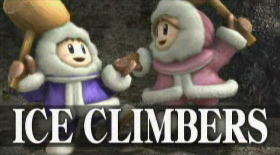
The Ice Climbers make their first appearance in The Glacial Peak, climbing up a mountain together, either potentially in pursuit of the Halberd or they were just climbing, being completely oblivious to the shootout between the Great Fox and the Battleship Halberd. When Meta Knight passed them going up the mountain, the Ice Climbers angrily took his quick ascent as a challenge and jumped up the mountain with Meta Knight. In the process, the Ice Climbers and Meta Knight warded off a portion of the Subspace Army along their routes with the mountain.
Upon reaching the summit, the Ice Climbers celebrated with their "victory" for managing to reach up to the mountaintop first, until they and Meta Knight encounter Lucario in a meditative stance on the peak of the mountain, who challenges Meta Knight to a sparring duel, while the Ice Climbers spectate from the side in agitation. After the fight, the victor revives the trophicated loser, to the relief of the Ice Climbers. The pair deem each other worthy and shake hands, making an alliance while the Ice Climbers cheerfully watch their reconciliation. However, relief is short-lived, as the Halberd suddenly plunges through the red clouds, ramming the Great Fox into the mountain while grabbing it with the ship's Combo Cannon. Although Meta Knight and Lucario managed to have the opportunity to board the Battleship Halberd, the Ice Climbers are ironically knocked back towards the canyon (along with a multitude of Shadow Bugs raining from the sky), where Marth, the Pokémon Trainer, Lucas and Ike reside. The latter two retreat for the Ice Climbers' landing on the ground, while the drizzling Shadow Bugs from the sky materialize a considerable ambush of the Subspace Army. The Ice Climbers, Lucas, Ike, the Pokémon Trainer and Marth team up to defeat the ambush of the Subspace Army, with the assistance of Mario, Pit, Kirby, Link and Yoshi.
After that, the ten fighters camp out for a while, until noticing an enormous explosion of Subspace Bombs from the Isle of the Ancients. The Battleship Halberd (now under control of Meta Knight, Snake, Lucario, Zelda/Sheik, Peach, Fox, Mr. Game & Watch, and Falco) and the Falcon Flyer (carrying Captain Falcon, Donkey Kong, Diddy Kong, Olimar, Samus, Pikachu and R.O.B.) land, reuniting with the rest of the other fighters.
After annihiliating the Subspace Gunship and invading the Subspace, the Ice Climbers and the other fighters eventually confront Tabuu. Unfortunately, the rest of the fighters have been effortlessly trophicated by Tabuu's off waves, including the Ice Climbers. However, the Ice Climbers and the rest of the other fighters are miraculously revived thanks to the efforts of Kirby, alongside Luigi, Ness, and King Dedede. After completing the Great Maze, the Ice Climbers and the other fighters confront Tabuu once again, and the latter prepares to trophicate the fighters another time by using his off waves, but Sonic shatters his wings, teaming up with the other fighters and eventually defeating Tabuu. In the end, the fighters successfully defeat Tabuu, including the Ice Climbers among them, resulting in the restoration of the World of Trophies and the obliteration of the Subspace.
Playable appearances
- The Glacial Peak
- Entrance to Subspace
- The Great Maze (if rescued in Subspace (Part II))
Exclusive stickers
These stickers can only be used by the Ice Climbers, or a select few including them:
- Balloon Fight Enemy: [Specials: Indirect] Attack +4
- Donbe: [Slash] Resistance +26
- Duck: Launch Resistance +20
- Fat Hockey Player: [Specials: Indirect] Attack +12
- F-Type: [Throwing] Attack +22
- Nana: [Specials: Direct] Attack +29
- Wild Gunman: [Specials: Indirect] Attack +5
- Yakuman Player: [Electric] Resistance +28
In Solo Modes
Classic Mode
In Classic Mode, Ice Climbers can appear as an opponent in Stage 9 on Summit. Ice Climbers can also appear as an opponent in Stage 11, but only if they haven't appeared in Stage 9.
All-Star Mode
In All-Star Mode, Ice Climbers are fought in Stage 4 on Summit.
Event Matches
Solo Events
- Event 11: Yoshi's Rainbow: As the Ice Climbers, the player must KO six Yoshis in the order of red, pink, yellow, green, cyan, and blue.
- Event 17: Super Waterfall Climb: Zelda must survive on Rumble Falls until the background changes into a waterfall. Two pairs of Ice Climbers will try to hinder the player's progress.
- Event 34: All-Star Battle Melee: Ice Climbers are one of the opponents fought in this event. All opponents are newcomers from Super Smash Bros. Melee.
Co-Op Events
- Co-Op Event 10: The R.O.B.'s of Tomorrow: Lucario and the Ice Climbers must defeat five R.O.B.s of varying sizes on Summit.
- Co-Op Event 21: The True All-Star Battle: Both players select a character and take on the entire roster on Battlefield.
Ending Images
Trophies
The Ice Climbers' main and Final Smash trophies can be obtained by clearing Classic Mode and All-Star mode respectively with the Ice Climbers.
- Ice Climbers
- The one in blue is Popo, and the one in pink is Nana. They use their incredible jumping powers and hammers to break blocks and climb to the summit. They grab veggies, and if they can catch the condor at the end, they conquer the mountain. Other than breaking blocks, their hammers are good for sending foes flying, climbing down from blocks, and destroying icicles.
: Ice Climber
- Iceberg
- The Ice Climbers' Final Smash. This giant ice mountain appears in the middle of a stage--it's incredibly slippery, so it's hard to control yourself when traversing it. In addition to being slick, this ice is also COLD, so opponents will take damage just from touching it. Attack the ice, and it will take damage and slowly shrink. Is it actually useful? That's a mystery.
: Super Smash Bros. Brawl
Alternate costumes
Nana becomes the leading, player-controlled character when using the 2nd, 4th, and 6th costumes shown below. The stock icons for these costumes change to reflect this, but the character select portraits always show Popo in front.

| |||||
Gallery
Using Blizzard on Link on Rumble Falls.
Popo footstooling Kirby on Lylat Cruise.
Taunting on Delfino Plaza.
Trivia
- Along with Pokémon Trainer, Diddy Kong, and Jigglypuff, the Ice Climbers are one of the only characters to have a unique "Defeated/No Contest" pose different from the traditional hand-clapping, with their head down while rubbing their eyes, depicting them crying. This pose is a reference to the one they make in Ice Climber after failing in a bonus level.
- If the player looks carefully, Nana can actually be seen smirking while crying while Popo is frowning. This is fixed in Ultimate.
- In Stamina mode, it is possible for the partner to die before the leader. Regardless of whether this happens or not, the partner will lay on the ground motionless, but not blink red.
- If the partner is caught in a trapping Final Smash and the leader is KO'd, the partner will disappear, leaving the opponent attacking nothing. Some examples are Ike's, Meta Knight's, Link's, and Toon Link's, and as seen here.
- Both Ice Climbers must win a microgame in the WarioWare, Inc. stage to be rewarded.
- Certain Final Smashes, especially trapping ones, can cause the trailing Ice Climber's special effects to be slowed down under the effect of a Timer (Nana's remains even after the Timer is done). The effects end when one or both of the Ice Climbers are KO'd.
- When CPU-controlled, if one Ice Climber is Star KO'd, the partner will sometimes taunt.
- Brawl is the only game where the portraits of the Ice Climbers are not swapped around when Nana is the leader, the only game where their default costume is not available in Team Battles and the only game where Nana leads the duo in all even-numbered costumes.
- If the leader dies in Stamina Mode without losing all their stamina, the partner will not disappear and can continue playing normally. This was later fixed in Ultimate.
- If the leader loses their stamina after the partner has been KO'd, but without losing all their stamina in Stamina Mode, the partner will respawn in the middle of the stage, but will still be defeated.
- The Ice Climbers, Ganondorf, Meta Knight, Mr. Game & Watch, and Samus are the only characters whose icon in the Subspace Emissary and the Sticker menu is not based on their renders.
External links
- Ice Climbers' page at Smash Bros. DOJO!!.
- Chain Grab Tutorial
- Ice Climber Character Guide on SmashBoards
- Ice Climbers' Chain Grabbing Every Character, 0% to death
- Ice Climbers' hitbox size of each of their moves, shown with Popo
| Fighters in Super Smash Bros. Brawl | |
|---|---|
| Veterans | Bowser · Captain Falcon · Donkey Kong · Falco · Fox · Ganondorf · Ice Climbers · Jigglypuff · Kirby · Link · Luigi · Mario · Marth · Mr. Game & Watch · Ness · Peach · Pikachu · Samus · Yoshi · Zelda / Sheik |
| Newcomers | Diddy Kong · Ike · King Dedede · Lucario · Lucas · Meta Knight · Olimar · Pit · Pokémon Trainer (Charizard · Ivysaur · Squirtle) · R.O.B. · Snake · Sonic · Toon Link · Wario · Wolf · (Zero Suit Samus) |
|
| |
|---|---|
| Fighter | Ice Climbers (SSBM · SSBB · SSBU) |
| Stages | Icicle Mountain · Summit |
| Items | Vegetables |
| Enemies | Polar Bear · Topi |
| Other | Condor |
| Trophies, Stickers and Spirits | Trophies (SSBM · SSBB) · Stickers · Spirits |
| Music | Brawl · Ultimate |
| Masterpiece | Ice Climber |





